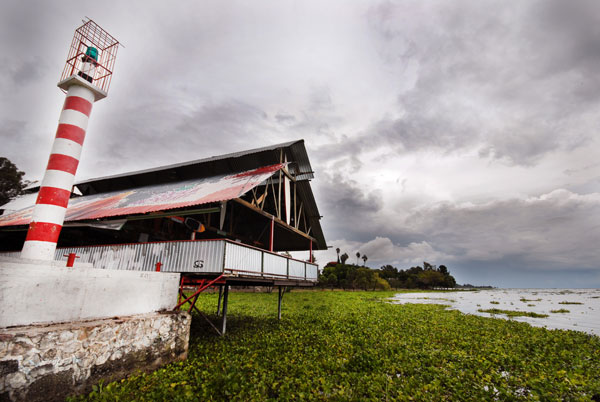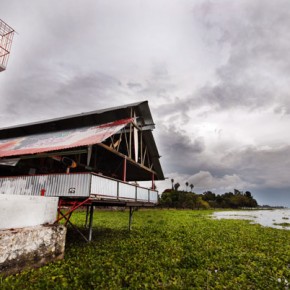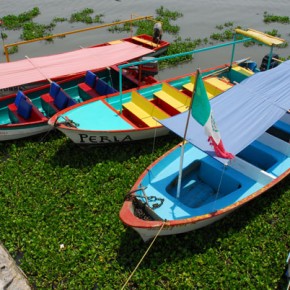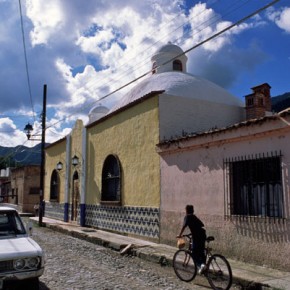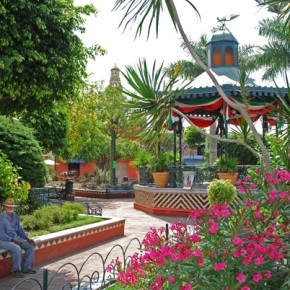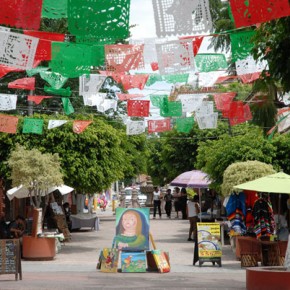Here’s a two-destination trip offering not only a big change from the Pacific Coast splendor of Ixtapa-Zihuatanejo but vivid contrasts between the two cities themselves: Ajijic and Mazamitla.
Both places are located northwest of here in the state of Jalisco, but while Ajijic can lay claim to being the ex-pat capital of Mexico, you might walk around Mazamitla for days without seeing another gringo.
The first step in getting to Ajijic (AH-he-heek) from Zihuatanejo is making it as far as Guadalajara, an easy one-day drive or (for us) a direct 7-1/2 hour overnight bus trip. From there, it’s just one more hour to this small town on the north shore of Lake Chapala, Mexico’s largest natural lake. Well…actually, it turned out to be half an hour more than that because of a traffic jam on the highway from the city of Chapala west to neighboring Ajijic, an occurrence the locals say is becoming more and more common these days. It reminded us of the regular north-of-the-border commuter snarl-ups we’d come to Zihuatanejo to avoid.
Once we were deposited at the intersection of the highway and Colon street, Ajijic’s main street, we walked about nine blocks to the Ajijic Guest House, a bed-and-breakfast where we’d booked a room at what turned out to be one of our favorite places to stay in all of Mexico. Boston native Gary DiTullio turned a ramshackle building a short walk from the lake into an intimate home away from home, offering three comfortable guest rooms and commodious public areas at bargain basement prices. The generous continental breakfasts he served each morning made me more determined to start the day back home as healthfully as we were doing here. (As the November 2009, issue of this magazine went to press, I learned Gary just sold his B & B, but if you google Ajijic, you’ll find a wealth of other possibilities, and the slowdown in Mexican tourism has resulted in some enticing vacation opportunities.)
You KNOW you’re in ex-pat heaven when you walk down ANY street in town and hear English spoken more often than Spanish. If you want to hear nothing but English, head over to the Lake Chapala Society. Anyone in town can point the way, and the spacious, well-tended grounds boast a gorgeous garden, a library, an eating area, a travel desk and more, and can be a wellspring of information to the occasional traveler thinking of making Mexico a part-time home. Here you’ll find friendly volunteers waiting to provide newcomers with advice on health and car insurance, real estate transactions, day trips, longer excursions, investments, cultural opportunities, bilingual doctors, etc. etc.
We went in October, and the cooler temperatures provided welcome relief from the sweltering humidity in Zihuatanejo, where the prevailing feeling this “autumn” was that of being in a sauna if you ventured outdoors after 9 a.m.
During an earlier visit several years back, Lake Chapala was in a most unhealthy state. The water had receded from shore nearly a kilometer. This time, although the lirio (water lilies) were still very visible, they had released their choke hold on the lake, and an evening meal at La Tasca, dubbed on one website as, “the view with a room,” provided a romantic shoreline dining experience complete with flickering candles at our outdoor table and the added ambiance of live music. We found restaurant prices very inviting not only here but at nearly every eatery we tried around town.
There are numerous art galleries and lots of shopping opportunities. The mountains rise steeply on the non-lake side of the highway, and we followed host Gary’s suggestion and hiked up a steep but fairly well-maintained trail to a chapel which looks dauntingly high from down below but takes merely half an hour to reach on foot. Start before the sun is overhead, and wear shoes with good traction to cope with the rubble along the way.
Another treat was the ciclopista (bike path) paralleling the highway. We borrowed bikes from Gary and headed to the nearby town of Ribera del Pilar to visit friends who’d relocated there from Zihuatanejo. The north shore of the lake is sprinkled with small communities catering to varying pocketbooks.
Then we journeyed on to Mazamitla, touted in tourist literature as either the Austria or Switzerland of Mexico due to the mountainous terrain. From Ajijic, we took a second class bus for about half an hour to Jocotepec at the west end of Lake Chapala, stopping long enough to have a bowl of birria (goat stew) on the main plaza. Virtually every restaurant was serving the same thing, so your only choice was the angle at which you faced the zócalo. We didn’t realize we’d have to hike back to the highway to flag down the bus headed for Mazamitla (which departed from Guadalajara), but our mile-plus walk used up the calories we’d consumed and gave us a chance to marvel at how “non-gringo-ized” things are, just a short distance from Ajijic.
The bus rumbled through a bunch of little villages before heading up into the mountains. Don’t read a book during this part of the trip or you’ll miss some spectacular scenery. After two hours, we reached our destination: an elderly bus station at an altitude almost 2,300 feet higher than Ajijic, meaning by now we were nearly 7,400 feet above sea level.
It was a 20-minute walk to our hotel, a rustic place featuring treehouse-like accommodations called Hotel Cabañas Colina de las Ruiseñores (ruiseñores means nightingales in Spanish). Along the way, we encountered no Americans or Canadians, just interested locals in long pants staring at our bare legs and light-colored hair. Once we got there, though, we chuckled every time we chatted with Guillermo, our congenial host, who was a dead ringer for Jerry Seinfeld’s buddy Kramer.
What a change from Zihuatanejo! Here we looked forward to having a fire in the chimenea (fireplace) every night, and we piled on at least a couple of blankets to ward off the chill of the mountain air when we went to sleep. During the heat of the day, we could still wear sleeveless tops and shorts (though almost none of the locals did), but at night long-sleeved T-shirts topped with a sweatshirt above blue jeans became our uniform. Traipsing along the outskirts of town surrounded by both the sight and smell of pine trees made me a tad homesick for Wisconsin. We scouted out a number of other hostelries we wished we had time to try out, but at least we know there are plenty of interesting choices out there, including lots more cabañas (cabins). The entire area is a camping mecca.
One could say, tongue in cheek, that Mazamitla is “well preserved,” given that virtually everywhere you went there were homemade fruit preserves for sale: peaches, apples, mangoes, pears…you name it, they had it. Then there were the cheeses, plentiful every day of the week but even more so during the Monday market. Like in Jocotepec, birria is a diet staple, but here the primary offering is beef rather than goat stew.
One of Mazamitla’s main attractions is Los Cazos, about three miles south of town. It’s a European-styled community shrouded in woods and traversed via cobblestone streets, dead-ending at a spot where you can descend via a challenging path to the base of a 115-foot waterfall. There are horses for hire, but walking affords you the opportunity to picnic or simply stop in your tracks to enjoy the scenery. Many of the homes you’ll see look like Alpine chalets, but few show any signs of life during the week, given that the owners are primarily wealthy folks from Guadalajara and Mexico City who come on the weekends to escape the craziness of big city life.
Unless you’re driving, getting back to Zihuatanejo from here is not a straight shot. We did it in three parts: a second class bus to Zamora, a first class bus to Uruapan, and a first class bus the rest of the way home. Both destinations, Ajijic and Mazamitla, made the “keeper” list for future trips.
- Ajijic Pier on Lake Chapala. Photo By Steven Miller.
- Lake Chapala Boats. Photo by Steven Miller.
- Streets of Ajijic. Photo by Tersina Shieh.
- Ajijic Plaza. Photo by Steven Miller.
- Ajijic Plaza Street. Photo by Steven Miller.

